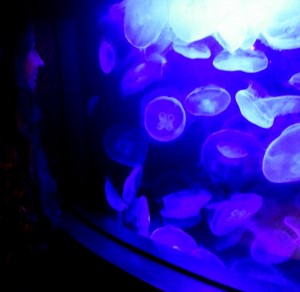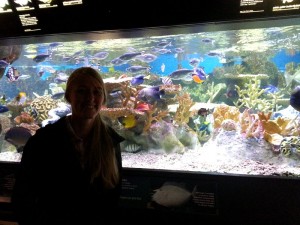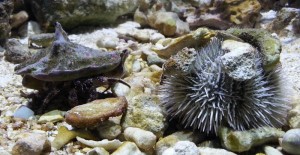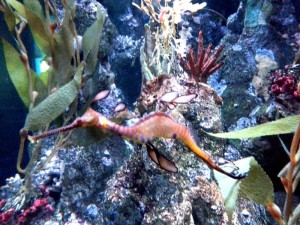Ecosystems in Balance, From Local to Global, Knowledge into Action, Sustainability Inside and Out, Sustainable Seafood, To Conserve and Protect
Alyssa Berger
Go to the New England Aquarium in Boston, and you’ll see wondrous jellies floating in their tanks, huge leopard-printed stingrays for kids to touch, and penguins diving through their exhibit. Little kids give happy squeals as they watch, interact, and even feel the aquarium’s creatures, but look a little farther, and you’ll find notes on sustainable habits, declining stocks, and what you can do to help. An intersection of fun and information, the aquarium both entertains and educates all ages of the general public, but when we visited, we saw the behind the scenes side that works to conserve species around the world.
We met with Meghan Jeans of the Conservation Department, who graduated from Colby with her Bachelors and later pursued a JD to try and best approach the policy governing marine systems. Despite how much the aquarium appeals to the general public, I found it interesting how she focused her work on corporations and even countries. Part of her job is to perform “risk assessments” for corporations such as supermarkets or distributors involved with selling fish. She noted how there can be many middlemen in the fishing industry, which can make it difficult to identify unsustainable practices and problems; at times, a company might not even be aware that somewhere up the chain, they are involved with, say, slave labor for example. By providing these risk assessments, Jeans and her department provide critical information for companies to make positive changes. Interestingly enough, even when she may find an alarming practice, she keeps confidentiality. While this may seem counterintuitive, it is imperative for building trust between corporations and groups like her department that advocate for change.
Beyond working with corporations here in the US, the Conservation Department provides funds to groups all over the world, a prime example of how despite being the New England Aquarium, they get involved wherever they can. They provide relatively small grants, but even these small grants can instigate enormous change. Recently, they gave a grant to a group in Iran, where such marine conservation work is relatively new. Through this system of grants, there exists a cultural and scientific exchange as well. The New England Aquarium provides monetary assistance plus other types of support, and the receiving group often comes to the New England Aquarium to express and explain their situations and findings. In such an interconnected world, these funds transcend their value through the exchange of knowledge they often lead to.
One of the areas that the aquarium is most involved in is the Phoenix Islands of the Republic of Kiribati. They have done extensive works and research there, and it is a country that doesn’t have very many resources to enforce the policies that the aquarium helps them create. Nevertheless, Jeans and her department is up to the challenge as they explore innovative ways to remotely monitor ships in the area, and this commitment exemplifies the dedication the Conservation Department gives to the areas and groups it works with.
The next time you visit the New England Aquarium, keep enjoying the sharks, stingrays, and penguins. Awe at the jellies and exotic fish, but remember that behind the scenes, the aquarium is working incredibly hard to preserve all the species that you so see and enjoy.
Leigh Moffett
The New England Aquarium is not only an aquarium, but also an important organization when it comes to marine policy, sustainability, and public education. There are numerous talks, presentations, and informative signs throughout the aquarium that are meant to educate the general public. However, the true facts and stories about different species and issues can easily be twisted if certain information is left out or simply misrepresented.
The Lion’s mane jellyfish at the aquarium can be found in a small circular tank, in the corner of the jellyfish area. The two small jellyfish inside the tank measured approximately one to two inches across the bell, and appeared to be floating peacefully. The small informational depiction next to the tank explained that these jellyfish had the potential to grow up to eight feet in diameter. Now, why is this an issue?
Lion’s mane jellyfish have become an issue in fjords where the currents and tides have shifted as a result of sea-level rise. Thousands and thousands of jellyfish find themselves trapped in these fjords with no way out, and the majority of them die because of overcrowding and a lack of food. It has not been decided whether this issue should classify Lion’s mane jellyfish as invasive species. The tiny Lion’s mane jellyfish in the New England Aquarium’s tank looked incapable of creating this kind of issue, but when you imagine thousands of eight-foot jellyfish packed together, you can understand why these jellyfish have become a problem.
The public would have difficulty understanding why Lion’s mane jellyfish are potentially being considered an invasive species if they are exhibited as being about one inch in diameter. Although the sizing information is written right beside the tank, a live, visual representation of a Lion’s mane jellyfish is more likely to capture the viewer’s attention. This representation of jellyfish, while true, is not completely accurate, leading to potential public misconceptions. Furthermore, these misconceptions can have broader implications on policy and sustainability measures.
Noah Paravicini
The New England Aquarium, located in Boston, MA, is a hub for public enjoyment and education in the city; the more than 1.3 million yearly visitors have the opportunity to view and learn about the 20,000 animals of 600 different species housed there (City Data, 2015), and the aquarium provides numerous educational resources for students, teachers, and the general public alike. However, the aquarium also prides itself on its conservation and research work; with these programs, it aims to make a lasting positive impact and “develop and implement new solutions to protect the oceans and balance the human impacts on them” (Conservation and Research, 2015). The aquarium has numerous programs and research efforts related to important topics such as endangered species & habitats, climate change, sustainable fisheries, bycatch and aquaculture, conservation medicine/ocean health, and marine animal rescue (Conservation and Research, 2015). These programs are prominent in the world of marine conservation, with many of them making significant impacts on marine systems and research efforts related to them.

Bureo Skateboards was founded with help from one of these small grants. They upcycle used fishing nets, taking them away from the ocean where they can cause serious harm.
One of these programs is the aquarium’s Marine Conservation Action Fund. MCAF is a micro-funding program aimed at funding “small-scale, time-sensitive, community-based” projects (MCAF, 2015). The advisory board, made up of NEAQ scientists and international experts who donate their time, approves 7-10 projects per year, and MCAF has funded more than 120 projects worldwide since its founding in 1999 (MCAF, 2015). An example of one of these projects is the “Protect Africa’s Sawfishes” project; the director of the project, Ruth Leeney, most recently traveled to Mozambique on funding from the MCAF to gather baseline information on sawfish populations and educate locals on how to report sightings. All five species of sawfish are classified as “endangered” or “critically endangered” by the International Union for Conservation of Nature (Leeney, 2014), with their distribution across Africa significantly lessened from its formerly widespread state. Leeney traveled throughout the nation collecting information on the fishes and raised awareness on the necessity of reporting all sawfish sightings and catches; she also provided certain individuals with training on sawfish identification and a sawfish recording kit. These efforts resulted in knowledge of where sawfish are most likely to be found in the region, a large step towards their conservation, which the project looks to develop a plan for soon. This is just one example of a project funded by the aquarium’s MCAF, proving the impact and reach that this program can have.
The conservation goal of these many programs of the NEAQ is a very important one, as the oceans are vital to the wellbeing of countless humans & animals alike. The aquarium makes helping this cause available to the public, with opportunities available to volunteer at the aquarium or intern with certain conservation & research programs (Get Involved, 2015). I am very regretful that I am not able to attend this trip to such a fascinating and important place.
Olivia Wiener
The New England Aquarium goes above and beyond simply providing an enjoyable afternoon for families and friends. In addition to having thousands of species on display for general walk throughs or tours, the aquarium offers a variety of programs like the lobster, traveling tide pool and shark’s programs, (Community Programs 2015) intended to connect citizens directly to these species in an effort to educate the community on marine life. They’re dedication to education is also demonstrated by their extensive classes and lectures designed for both children and adults to learn more about our great blue planet and has been successful in reaching “more than 30,000 children and families” (Programs, Classes and Lectures 2015) annually. The hands on opportunities are unparalleled and allow visiting patrons to become one with the aquatic life and not only touch sting rays and sharks but become situated with the seals and other species by entering their tanks. However, what makes the New England Aquarium genuinely exceptional and unique is their commitment to conservation and research.
The conservation and research projects currently occurring span a copious number of topics including but not limited to, protection of endangered species and habitats, exploring climate change and oceans, managing sustainable fisheries, bycatch and aquaculture and marine animal rescue (Conservation and Research 2015). Despite all these fascinating opportunities, the most compelling one files under their tools for conservation and examines the potential usage in Marine GIS technology (Conservation and Research 2015). GIS is “geographic information systems,” (Marine GIS 2015) and is a tool that allows scientists to “organize and analyze complex marine data through time and space” (Marine GIS 2015). This program has been greatly utilized for quite some time now, originating at the aquarium in 1995 (Background on Marine GIS 2015).
The usages for such technology are crucial, ranging from right whale protection to summer camp festivities (Current GIS Projects 2015). Aside from tracking the dwindling population of right whales, the system is partnered with the aquarium’s Marine Animal Rescue Program to watch over “thousands of stranded, injured or sick marine animals” (Current GIS Projects 2015) by attaching satellite tags to them. One of the many success stories involves a harbor seal named Quid who arrived at the aquarium during the summer of 1998 with alarming eye infections (Quid the Harbor Seal 2015). The fear was that because of the difficulty in treating eye infections in seals, Quid would sustain permanent damage which would inhibit him from living a normal life in the open ocean. Thankfully the aquarium was able to invent a system designed specifically to alleviate his symptoms and with the help of GIS, scientists were able to tag him and monitor his travels and safety (Quid the Harbor Seal 2015). GIS has had ongoing success in watching over rehabilitating animals and will continue to do so at the New England Aquarium for many years to come.
Mackenzie Scurka
The New England Aquarium funds and oversees many outreach and research programs that aim to educate, involve, and excite the public on issues concerning marine environments. Even outside the workplace, the aquarium sponsors trips around the world to regions such as the Gulf of Mexico, New Zealand, and Thailand to observe and collect data from a wide variety of species to best learn how to conserve and protect different ecosystems (Conservation and Research, 2015). Their findings are not only sent to other scientists around the world, but also back to New England where they are shared with the aquarium and the community that surrounds it, including more than 30,000 children and families (Community Programs, 2015). Some of the outreach programs for these young people include the Lobsters Program, the Traveling Tidepool Program, and the Sharks! Program (Community Programs, 2015). Though these activities differ in content, they all share a common characteristic: they are interactive and presented in a fun way, encouraging kids to get hands-on with the subject matter.
Although the aquarium hosts outreach programs that can be accessed by anyone, some of their research programs can only be carried out by experts. Some projects aim to protect endangered species and habitats, such as sea turtles and coral reefs. Others are concerned with broader concepts like climate change and aquaculture (Global Projects, 2015). One project that particularly caught my eye, however, was an experiment involved tracking sharks in the Virgin Islands. Using passive acoustic telemetry, a tracking technique using sound, researchers were able to follow the whereabouts and travelling patterns of nearly 20 sharks in St. Croix (Global Projects, 2015). Their findings were significant, but not only for the sharks themselves. Many other species are dependent on the locations, numbers, and habits of this apex predator. Its presence or absence could determine whether a reef is dominated by algae or coral (Global Projects, 2015). The scientists discovered that one particular group of sharks they were studying was very dependent on one location called the Buck Island Monument. The sharks’ loyalty to this spot assures the stability of other organisms in the area (Global Projects, 2015).
The more a topic is studied, understood, and spoken about, the more support it gets since the public recognizes issues that are vivid and salient. The New England Aquarium is so important because it conducts research and then converts it into outreach programs and media outlets, such as blogs, that introduce the public to issues concerning the ocean. The St. Croix sharks, along with other research subjects, are being accredited an increasing amount of attention due to studies directed by institutions similar to the New England Aquarium. With attention comes awareness, and with awareness comes conservation. With a large enough audience, the New England Aquarium has the power to make a significant impact on marine ecosystems around the globe.
Everest Crawford
The New England Aquarium is a well-respected tourist destination and center for marine research located in Boston Massachusetts. The resources and efforts of the aquarium include preservation work for endangered species, such as the North Atlantic Right Whale, also efforts to reduce the impact of commercial fishing though sustainable aquaculture. A large part of the aquariums conservation impact comes from supporting environmental research efforts, and making the marine ecosystems at risk more available to the public.
Exhibits of natural marine ecosystems in the aquarium range from rocky coasts inhabited by harbor seals to large Pacific reef systems, and beaches occupied by the iconic African Penguins who greet visitors to the aquarium. The aquarium makes an unbelievably large amount of otherwise distant organisms available to its visitors. Some of the most exotic and fascinating organisms include the mystifying sea dragons, the eerie box jelly fish and the awe inspiring and majestic green sea turtles in the central tank. Those who visit the aquarium with no prior knowledge of this exceptional range of aquatic life, the sheer size of the building could be shocking, but the aquarium employees make it simple to learn more about dozens of organisms with being too over whelmed. Several exhibits have historically gained the most acclaim from visitors, young and old alike, the harbor seal play area allows the wonderful yet fragile New England native to take the hearts of visitors, while the inhabitants of the large central tank often impress with their size, and I’m sure feeding the handsome green sea turtles fresh lettuce has made the dreams of at least a few youngsters to become a marine biologist. (Animals)
Speaking as someone who has lived most of their life in New England, and has visited the New England aquarium countless times, including in the past year, I can certainly speak of its influence. Raised near the ocean both on the coast of Massachusetts and the North shore of Oahu, I have always loved the marine world. Early in my life though, the aquarium played a large role in my love of its inhabitants. From experience, my first several trips to see the animals there, from the pelagic fish, to the lobsters and exotic crustaceans to the jellyfish, I began to aspire to learn more about them. In essence the New England aquarium made the marine ecosystems of the world more salient and vibrant to at least one young visitor. Thanks to my experiences I have grown up environmentally aware and strive to make the world and oceans a better place for the future. For the current generation of rising students of the Ocean, the outreach program the aquarium offers are able to bring young children an “intimate, hands on learning experience.” This returns to a major factor of worldwide conservation efforts, simply teaching people about the many benefits of marine ecosystems and how they can help preserve them. The New England aquarium has been able to successfully implement teaching tools, and is a major supporter of environmental education. (Programs and Classes)
More Posts
Ecosystems in Balance, From Local to Global, Knowledge into Action, Sustainability Inside and Out, Sustainable Seafood, To Conserve and Protect





